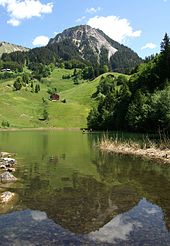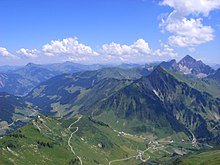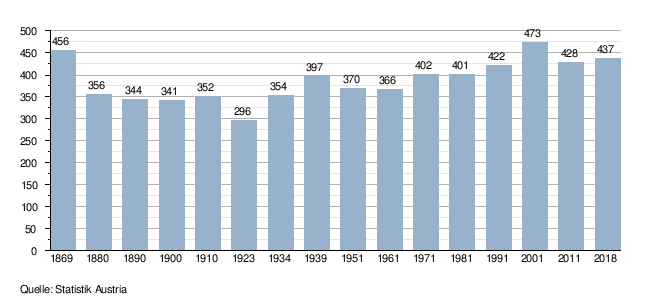Fontanella, Austria
This is the sighted version that was marked on September 29, 2020. There is 1 pending change that needs to be sighted.
![]()
The title of this article is ambiguous. For other meanings, see Fontanella (disambiguation).
Fontanella is a municipality in the district of Bludenz in the Austrian state of Vorarlberg with 457 inhabitants (as of 1 January 2021).
The village is situated at an average altitude of 1145 m above sea level in the northernmost part of the Great Walser Valley.

View from the lake Seewaldsee to the Blasenka

View from the Glatthorn to the Faschinajoch
Geography
Fontanella is the highest mountain village of the "Biosphärenpark Großes Walsertal". 29.5 % of the area is forested, 52.1 % of the area is alpine. Due to its location at the north-eastern end of the Great Walser Valley, the Bregenzerwald village of Damüls can be reached via the Faschinajoch.
Community structure
The municipal area comprises the following seven villages (number of inhabitants as of 1 January 2021 in brackets):
- Faschina (30)
- Fontanella (219)
- Garlitt (10)
- Mittelberg (128)
- Saw (9)
- Seewald (7)
- Türtsch (54)
The municipality consists of the cadastral municipality Fontanella.
History
The village was settled in the 14th century by Walliser colonists who reached this area via Graubünden-Laterns-Damüls and belonged to the Walser court of Damüls. Fontanella was first mentioned in a document in 1363 as "Funtanell". The place name is derived from a Roman word, the diminutive of "fontana" (= well, spring). It was taken from an old healing spring in this area. The "Heilbrünnlein" is said to have been fed by a ferruginous spring. The place came to Austria in 1390 together with the dominion of Feldkirch.
The Habsburgs ruled the towns in Vorarlberg alternately from Tyrol and Vorderösterreich (Freiburg im Breisgau). From 1805 to 1814 the place belonged to Bavaria, then again to Austria. Fontanella has belonged to the Austrian province of Vorarlberg since its foundation in 1861.
From 1945 to 1955 the village was part of the French occupation zone in Austria.
- See also: 1954 avalanche disaster in Vorarlberg
Population development

The share of non-Austrian citizens was 5.7 percent at the end of 2002 and 5.0 percent in 2018.
The migration balance has been negative since 1981, but could be balanced by the strongly positive birth balance until 2001. After 2001, the birth rate decreased and emigration increased, resulting in a decline in the number of inhabitants.
Search within the encyclopedia